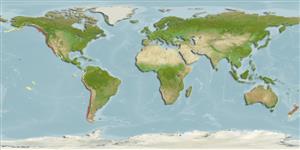>
Gobiesociformes (Clingfishes) >
Gobiesocidae (Clingfishes and singleslits) > Gobiesocinae
Etymology: Gobiesox: Latin, gobius = gudgeon + Esox, the old name for "pike" (Ref. 45335).
More on author: Girard.
Environment: milieu / climate zone / depth range / distribution range
Ecologia
marino demersale; distribuzione batimetrica 0 - 8 m (Ref. 2850). Subtropical; 59°N -
Eastern Pacific: Revillagigedo Island, southeastern Alaska (Ref. 27436) to southern California, USA; also off Baja California, Mexico.
Size / Peso / Age
Maturity: Lm ? range ? - ? cm
Max length : 16.0 cm TL maschio/sesso non determinato; (Ref. 2850)
Short description
Chiavi di identificazione | Morfologia | Morfometria
Spine dorsali (totale) : 0; Raggi dorsali molli (totale) : 13 - 16; Spine anali: 0; Raggi anali molli: 12 - 14. Caudal fin well rounded; pectorals short and broad, a fleshy pulp between the base of the fin and the gill opening; pelvic fins united anteriorly by a papillose membrane, the rays are flexible and support the lateral rim of a prominent adhesive disc; the disc is completed posteriorly by a broad fringed fold of skin on the lower part of the body, and is separated from the pelvic fins by a deep notch (Ref. 6885). Light olive brown to cherry red, reticulated with darker or mottled with light shades; dark radiating lines from eyes and joining the eyes through a series of reticulations; white bars between eyes and in young across back and on edge of caudal fin (Ref. 6885).
Facultative air-breathing in the genus (Ref. 126274); Found in intertidal rocky areas among algae, and on kelp (often high in kelp canopy) (Ref. 2850). May remain out of water under rocks or seaweeds (Ref. 31184). Feeds on small crustaceans and mollusks (Ref. 6885). Breathes air when out of water (Ref. 31184).
Life cycle and mating behavior
Maturità | Riproduzione | Deposizione | Uova | Fecundity | Larve
Eschmeyer, W.N., E.S. Herald and H. Hammann, 1983. A field guide to Pacific coast fishes of North America. Boston (MA, USA): Houghton Mifflin Company. xii+336 p. (Ref. 2850)
IUCN Red List Status (Ref. 130435: Version 2024-1)
Threat to humans
Harmless
Human uses
Pesca: commerciale; Acquario: Acquari pubblici
Strumenti
Special reports
Download XML
Fonti Internet
Estimates based on models
Preferred temperature (Ref.
123201): 8.9 - 17.2, mean 10.8 °C (based on 346 cells).
Phylogenetic diversity index (Ref.
82804): PD
50 = 0.5000 [Uniqueness, from 0.5 = low to 2.0 = high].
Bayesian length-weight: a=0.00617 (0.00250 - 0.01521), b=3.15 (2.94 - 3.36), in cm total length, based on LWR estimates for this (Sub)family-body shape (Ref.
93245).
Trophic level (Ref.
69278): 3.4 ±0.3 se; based on diet studies.
Resilienza (Ref.
120179): Basso, tempo minimo di raddoppiamento della popolazione 4.5 - 14 anni (Annual fecundity = 382).
Fishing Vulnerability (Ref.
59153): Low vulnerability (10 of 100).
